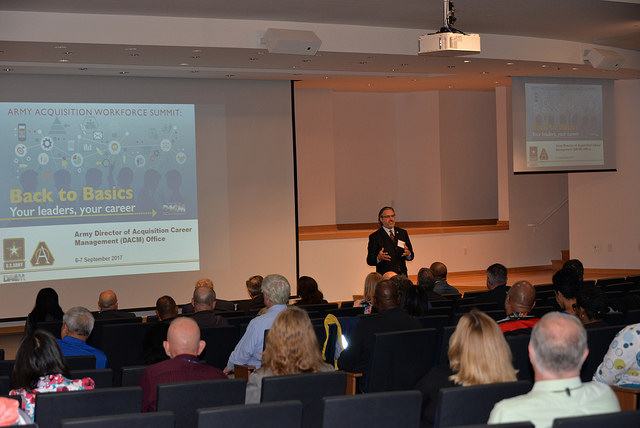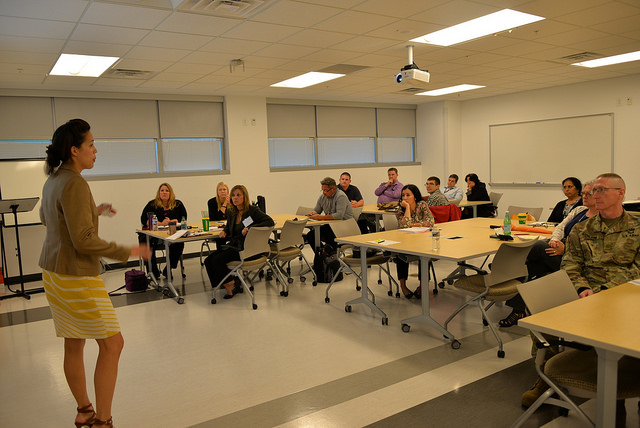
Army DACM Office hosts first career summit
By Tara Clements
FORT BELVOIR, Va. (Sept. 20, 2017) – The U.S. Army Director for Acquisition Career Management (DACM) Office took to the road Sept. 6-7 to break down the basics of career management to the nearly 2,000 Army acquisition professionals at Aberdeen Proving Ground (APG), Maryland.
“We are a business of people,” Gary Martin, program executive officer for Command, Control and Communications – Tactical, said during the opening session. “Today’s session is about you and the business of acquisition workforce development.”
“Army Acquisition Workforce Summit: Back to Basics” included two general sessions and eight breakouts over two days at APG-North and APG-South. “This is an opportunity to refresh or in many instances start the dialogue on what it means to be an Army Acquisition Workforce member,” said Kelly Terry, the Army DACM Office’s lead planner for the event.

Stephanie Watson, acquisition career manager with the Army DACM Office, hosts a breakout session on career planning tools, including the Career Acquisition Personnel and Position Management Information System, the Acquisition Career Record Brief, the individual development plan and the Senior Rater Potential Evaluation.
The summit is a pilot program aligned with the Army Acquisition Workforce (AAW) Human Capital Strategic Plan, launched in October 2016. One of the plan’s goals is to improve communication and collaboration across the AAW. “While automation and technology are wonderful tools, we also know that it helps to hear directly from the experts—so we came here to do just that,” added Terry.
The event was open to everyone, from interns to leaders, from 10 commands in the APG area that are a part of the AAW, which totals more than 38,000 professionals worldwide.
“We are excited to learn about what opportunities are available for our career development. As interns, we are like sponges, soaking up all the information,” said Alyson Fritz, an operations research analyst intern at the U.S. Army Communications-Electronics Command G-8.
Planning for breakout sessions was a collaborative effort between the Army DACM Office and the organizations at APG. Topics included:
- An overview of what the Army DACM Office is and what it does.
- Where to find civilian career development models for all acquisition career fields.
- How to apply for leader development.
- Education and training programs available to the AAW.
- How to develop a strong packet for competitive opportunities and positions.
- Certification requirements derived from the Defense Acquisition Workforce Improvement Act (DAWIA).
- Career development opportunities for military members of the AAW.
“I appreciated learning the benefit of each course and how they build,” said Jennifer Thermos, deputy product director at the Joint Program Executive Office for Chemical and Biological Defense. “It was tremendous. The [Army] DACM Office put all the pieces of the puzzle together for me.”
![“We are here to support our warfighters, and that requires us to do our job properly … I had to figure out what to do to become a [program manager],” said Michael Abaie, director of the Engineering Directorate within the U.S. Army Edgewood Chemical Biological Center.](https://asc.army.mil/web/wp-content/uploads/2017/09/36694266120_86ee5caf9e_z.jpg)
“We are here to support our warfighters, and that requires us to do our job properly … I had to figure out what to do to become a [program manager],” said Michael Abaie, director of the Engineering Directorate within the U.S. Army Edgewood Chemical Biological Center.
“There is no one path for civilians,” Scott Greene, chief of leader development for the Army DACM Office, said during his discussion on career planning and how to find and use the career models for each acquisition career field.
Planning career paths is very different for military versus civilian professionals. And with civilians comprising 95 percent of the AAW, understanding the tools available to help with planning is a plus. Jason Pitts, chief of acquisition functional integration at the Army DACM Office, outlined some of the top resources for civilians and military personnel, starting with the Army DACM Office website.
The summit marked the first time in years that the Army DACM Office coordinated an event on this scale to increase communication with individual workforce members. The team that coordinated the event met recently and is in the process of determining whether similar events will be held in the future.
Watch the recap video.
Access the briefings from the summit, including the general session and breakouts, on AKO (CAC access required).
Subscribe to Army AL&T News, the premier online news source for the Acquisition, Logistics, and Technology (AL&T) Workforce.







